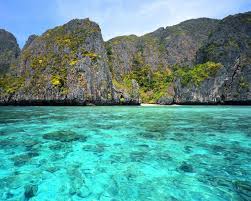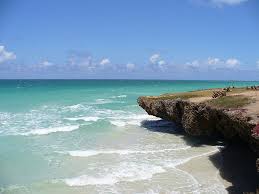 CUBA DESCONOCIDA: LA LAGUNA DE MAYA, UN REFUGIO DE LA FLORA Y FAUNA CUBANA.
CUBA DESCONOCIDA: LA LAGUNA DE MAYA, UN REFUGIO DE LA FLORA Y FAUNA CUBANA.
Laguna de Maya es un área al nordeste de Matanzas, entre la bahía y el poblado de Carbonera. Es un Área Protegida de Cuba categorizada como Refugio de Fauna, debido a la gran cantidad y diversidad de especies en la zona, muchas de ellas endémicas de Cuba y la región.
El área posee 966,00 hectáreas, de ellas 565,70 terrestres y 400,30 marinas.
Laguna de Maya debe su nombre a grandes lagunas de agua salada existentes en el lugar. Están conectadas al mar e intercambian con el mediante varios canales naturales. La profundidad de las lagunas oscila entre 0.4 y 2 metros. El fondo en algunos lugares es fangoso, en otros rocosos.
La flora del lugar cuenta con 79 especies, pertenecientes a 45 familias y 69 géneros. La Uva Caleta (Caccoloba uvifera) y el mangle son las especies vegetales dominantes de la costa arenosa y en las partes cenagosas de la laguna.
Entre sus especies faunísticas sobresalen lagartos del genero Anolis dentro del cual hay una especie endémica de Cuba el (A. porcatus), también existen bayoyas del género Leiocephalus, dentro de las cuales hay dos exclusivas de la isla.
La familia Asteraceae está muy bien representada con especies como: Bidens pilosa (acetillo), Borrichia arborescens, Iva cheiranthifolia y Sphagneticola gracilis. Abundan reptiles como los lagartos del género Anolis (A. porcatus), especie endémica de Cuba; así como las bayoyas del género Leiocephalus (L.cubensis, L. stictigaster), ambas endémicas del país.
Algunos ofidios abundan como: Alsophis cantherigerus y Antillophis andreae, este último endémico de Cuba. En la época invernal este sitio constituye uno de los más importantes en la protección y refugio de las aves migratorias que provenientes de Norteamérica, transitan por el corredor.
El área marina de Laguna de Maya se destaca por su barrera coralina paralela a la costa de indescriptible belleza. Es un arrecife con un variado ecosistema donde conviven gran cantidad de especies de corales, peces, crustáceos y algas. La profundidad allí oscila entre 0.5 y 15 metros.
La fauna marina en la zona está representada por casi 200 especies. Se han identificado 33 especies de corales, 3 de hidrozoos, 2 de anémonas, 3 de coralimorfarios, 32 de gorgonias, 25 de esponjas, 14 de equinodermos, 35 de moluscos y un total de 48 especies de peces.
 UNKNOWN CUBA: LAGUNA DE MAYA, A REFUGE OF FLORA AND CUBAN FAUNA.
UNKNOWN CUBA: LAGUNA DE MAYA, A REFUGE OF FLORA AND CUBAN FAUNA.
Laguna de Maya is an area northeast of Matanzas, between the bay and the town of Carbonera.
It is a Protected Area of Cuba categorized as a Wildlife Refuge, due to the large number and diversity of species in the area, many of them endemic to Cuba and the region.
The area has 966.00 hectares, of which 565.70 land and 400.30 marine.
Laguna de Maya owes its name to the large saltwater lagoons that exist on the site. They are connected to the sea and interchange with it through various natural channels. The depth of the lagoons ranges from 0.4 to 2 meters. The bottom in some places is muddy, in other rocky.
The flora of the place has 79 species, belonging to 45 families and 69 genera. Caleta grape (Caccoloba uvifera) and mangrove are the dominant plant species on the sandy coast and in the swampy parts of the lagoon.
Among its fauna species, lizards of the genus Anolis stand out, among which there is a species endemic to Cuba (A. porcatus), there are also bayoyas of the genus Leiocephalus, among which there are two exclusives to the island.
The Asteraceae family is very well represented with species such as: Bidens pilosa (acetillo), Borrichia arborescens, Iva cheiranthifolia and Sphagneticola gracilis. Reptiles abound such as lizards of the genus Anolis (A. porcatus), an endemic species of Cuba; as well as the bayoyas of the Leiocephalus genus (L. cubensis, L. stictigaster), both endemic to the country.
Some ophidians abound like: Alsophis cantherigerus and Antillophis andreae, the latter endemic to Cuba. At wintertime this site is one of the most important in the protection and refuge of migratory birds that come from North America, passing through the corridor.
The Laguna de Maya marine area stands out for its coral reef parallel to the coast of indescribable beauty. It is a reef with a varied ecosystem where a large number of species of corals, fish, crustaceans, and algae coexist. The depth there ranges from 0.5 to 15 meters.
The marine fauna in the area is represented by almost 200 species. 33 species of corals, 3 hydrozoans, 2 anemones, 3 coral-morphs, 32 gorgonians, 25 sponges, 14 echinoderms, 35 mollusks, and a total of 48 species of fish have been identified.
Agencies/ Wiki/ Various/ Internet Photos/ Arnoldo Varona/ www.TheCubanHistory.com
THE CUBAN HISTORY, HOLLYWOOD.









